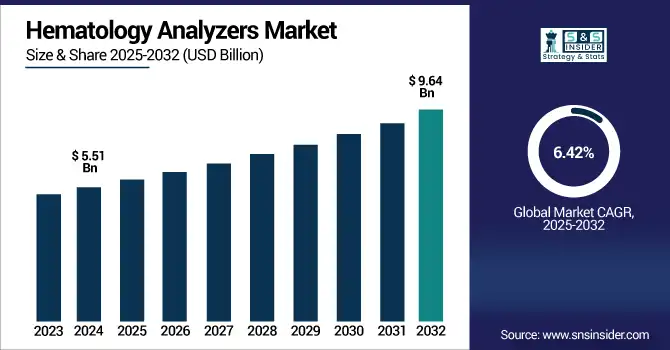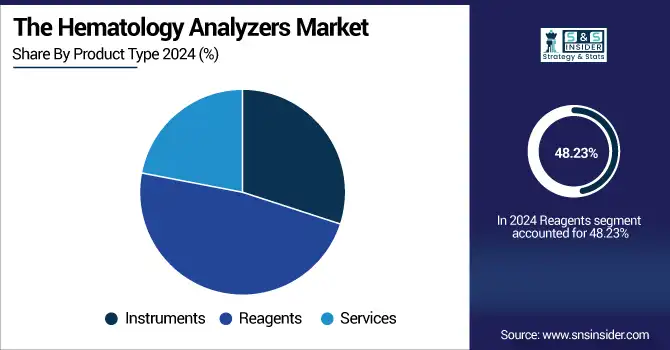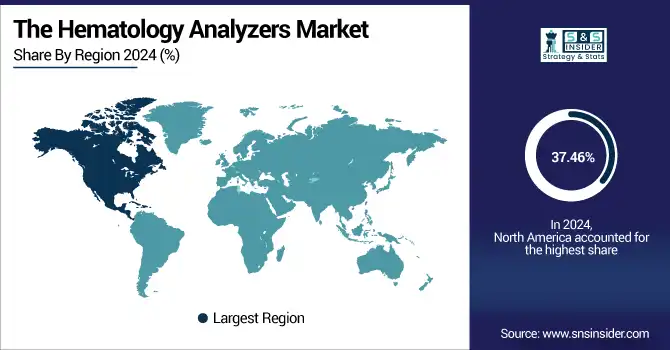Hematology Analyzers Market Size Analysis
The Hematology Analyzers Market was valued at USD 5.51 billion in 2023 and is expected to reach USD 9.64 billion by 2032, growing at a CAGR of 6.42% from 2024-2032.
In this report, we conduct an in-depth analysis of the Hematology Analyzers Market with distinctive insights on the incidence and prevalence of hematological disorders, more particularly targeting diseases like anemia and blood cancers, that have a direct impact on hematology testing demand. We further examine regional trends in prescriptions, highlighting changes in diagnostic practices region-wise and automated hematology analyzers adoption. The device volume by geography underscores the growth in sales of hematology analyzers, particularly in North America, Europe, and Asia Pacific. We also discuss healthcare expenditure trends by geography, including government, commercial, private, and out-of-pocket expenditures, giving an overall insight into market trends.

To Get more information on Hematology Analyzers Market - Request Free Sample Report
Hematology Analyzers Market Dynamics
Drivers
-
Growing Incidence of Blood Disorders Propelling the Hematology Analyzers Market
The growing incidence of blood disorders like anemia, leukemia, and other blood-related diseases is a major growth driver for the hematology analyzers market. Anemia, as reported by the World Health Organization (WHO), preys on about 24.8% of the world's population, with a high prevalence seen in low- and middle-income nations. The increasing incidence of blood diseases is fueling demand for precise diagnostic devices like hematology analyzers. The requirement for early detection, effective diagnosis, and treatment monitoring keeps driving the demand for sophisticated hematology analyzers in hospitals and diagnostic facilities. Such recent advancements as FDA clearance of Abbott's Alinity h-series hematology system further enhance this growth by providing more accurate and quicker diagnostic powers.
-
Hematology Analyzer Technological Upgrades accelerating the Market growth.
Continued advancements in hematology analyzers, including the incorporation of artificial intelligence (AI) and automation, are driving market growth. These technologies improve accuracy, speed, and efficiency in the diagnosis of blood disorders. For example, Siemens Healthineers introduced the Atellica HEMA 570 Analyzer in May 2023, which offers faster results with fewer workflow barriers. Also, the availability of next-gen analyzers that can conduct a range of tests like CBC and platelet counts enhances the clinical value of such devices. These technological advancements enhance diagnosis, but also minimize human error, thereby contributing to better patient outcomes. This has enhanced the attractiveness of hematology analyzers to healthcare institutions and laboratories around the world.
Restraint
-
High Cost of Advanced Hematology analyzers Restraining the market growth
The prohibitive cost of sophisticated hematology analyzers is a major limitation to market expansion, especially in low- and middle-income nations. Such analyzers, which are furnished with high-end technologies like automation and artificial intelligence, may be limited by their price tag to acquire, install, and maintain. Smaller hospitals and clinical centers with limited financial resources find it unaffordable to make the initial investment and cover the operational costs of such machinery. The average cost of high-end hematology analyzers can be anywhere from USD 10,000 to USD 150,000. This financial barrier hinders the universal adoption of sophisticated hematology analyzers, especially in areas with limited healthcare budgets.
Opportunities
-
The increasing demand for point-of-care (POC) hematology analyzers presents a significant opportunity for market growth.
As healthcare systems concentrate on providing quicker results, particularly in emergency and remote locations, demand for easy-to-use, portable analyzers has increased. The devices provide rapid diagnostic results, enhancing the care of patients and decreasing wait times. Based on recent developments, the usage of POC devices is poised to increase based on their potential to deliver results outside the standard laboratory environment. With healthcare practitioners looking to make their operations more efficient and to ease the load on centralized labs, POC hematology analyzers are picking up steam, offering plenty of room for growth and innovation. The growth of telemedicine and home healthcare services also fuels this demand further, with patients increasingly opting for in-home diagnostic equipment due to convenience and accessibility.
Challenges
-
The hematology analyzers market faces significant challenges related to regulatory compliance and approvals.
The hematology analyzers market is subject to major regulatory hurdles and approvals. Due to the complexity and accuracy involved in hematology testing, manufacturers have to comply with rigorous regulatory standards, including those provided by the U.S. Food and Drug Administration (FDA) and the European Medicines Agency (EMA). Regulatory clearance is a time-consuming and expensive process, particularly for new product innovations and developments. Delays or issues in securing approval can slow down the product launch and market entry, and hence, it is a serious challenge for manufacturers. Compliance with ever-changing regulations also contributes to the operational complexity. The growing emphasis on patient confidentiality and data security also necessitates ongoing product revisions, complicating the regulatory environment for manufacturers and healthcare organizations.
Hematology Analyzers Market Segmentation Analysis
By Product Type
The Reagents segment dominated the hematology analyzers market with a 48.23% market share in 2023 because of their pivotal role in conducting blood tests and their accuracy in delivering results. Reagents play a key part in the operation of diagnostic tests on hematology analyzers, such as complete blood count (CBC) tests, which are the most frequent ones conducted in clinical and laboratory environments. Their ongoing requirement for replenishment and the extensive application of hematology analyzers in hospitals and diagnostic centers played a major role in the dominance of this segment. In addition, the growing incidence of blood disorders, including anemia, leukemia, and hemophilia, has increased demand for reagents, which are an essential component of hematology diagnostic kits.
In addition, technological developments in reagent formulations, including the creation of more stable and accurate reagents, have also played a part in their market dominance. These developments enable enhanced accuracy, speed, and efficiency in blood tests, promoting their uptake in developed and emerging economies. As the emphasis on early and personalized diagnostics increases, demand for high-quality reagents also increases, further cementing their position in the hematology analyzers market. In addition, the strong reagent consumption rate, together with their relatively lower initial investment compared to instruments, has propelled the growth and continued dominance of the reagents segment.

By Price Range
The Mid-range Hematology Analyzers segment dominated the Hematology Analyzers Market with 46.25% market share in 2023 because they are affordable, versatile, and have the best features-per-dollar combination. They provide fundamental capabilities needed for every day diagnostics, including complete blood count (CBC), making them well-liked in hospitals, clinical laboratories, and other small healthcare institutions. Their affordability, coupled with consistent performance, enables healthcare professionals to perform necessary tests without the cost burden of high-end machines. In addition, mid-range hematology analyzers are simpler to maintain and give fast results, fulfilling the demands of healthcare professionals for efficient and cost-effective solutions. These, along with rising demand for diagnostic tests in developing economies, have established mid-range analyzers as the go-to for a broad spectrum of healthcare centers, particularly those with tight budgets.
The High-end Hematology Analyzers segment is expected to grow at the fastest rate with 8.70% CAGR during the forecast period due to the growing demand for sophisticated, high-accuracy diagnostic tools. These analyzers come with the latest technologies, which provide higher throughput, better accuracy, and the capacity to conduct more varied specialized tests such as uncommon blood disorders, cancer markers, and genetic studies. High-end hematology analyzers are finding wide acceptance among big hospitals, research centers, and high-volume laboratories where accurate, fast, and detailed results are of great importance. The high-end automation, integration with laboratory information systems (LIS), and ability to perform complex tests render high-end analyzers critical to contemporary healthcare use. The continuous shift towards personalized medicine, necessitating advanced diagnostics for improved patient care, is driving the need for these high-end devices.
By End-Use
The Hospitals segment dominated the hematology analyzers market in 2023 owing to the indispensable position that hospitals have in the provision of integral healthcare services, such as diagnostic testing. The largest buyers of hematology analyzers are normally hospitals because they provide various services, such as emergency, inpatient, and outpatient clinics. Hematology analysis, including complete blood counts (CBC), plays a critical role in the diagnosis of many diseases, including infections, anemia, and malignancies of the blood, and therefore forms a bedrock of day-to-day hospital diagnostics. High patient flow within hospitals and the necessity of getting quick and reliable results contribute to the need for hematology analyzers in these institutions. Also, hospitals enjoy better access to resources, allowing them to spend on better technology to enhance the efficiency of diagnostics and patient care. The existence of specialized units such as oncology, hematology, and internal medicine adds to the prevalence of the hospital segment in the market.
Hematology Analyzers Market Regional Insights
North America dominated the hematology analyzers market with 37.46% of the market share in 2023 on account of some major factors such as superior healthcare infrastructure, elevated healthcare spending, and strong regulatory environments. The U.S. specifically has a high concentration of diagnostic labs and hospitals that require leading-edge hematology analyzers. Moreover, the regulatory landscape in North America, especially the FDA's clearance procedures, offers an open and effective system for the development and distribution of these devices. This, coupled with robust investments in healthcare research and technology, has enabled the region to continue its dominance in the hematology analyzers market. Also, the growing rate of blood diseases and disorders like anemia and leukemia raises the demand for hematology tests in the region.
The Asia Pacific region is expected to exhibit the fastest growth with 8.36% CAGR throughout the forecast period because of the accelerating demand for healthcare services, enhanced healthcare infrastructure, and an increasing population. Economies such as China, India, and Japan are also seeing major leaps in diagnostic technology, leading to more use of hematology analyzers in hospitals as well as clinical laboratories. Further, rising awareness of healthcare issues, combined with increasing healthcare spending, is also driving the need for advanced and precise diagnostic tools. As healthcare facilities in developing economies such as China and India are modernizing at a fast pace, the demand for cost-efficient, effective hematology analyzers is increasing manifold. With increased chronic diseases and more emphasis on preventive care, Asia Pacific will witness high growth in the market in the next few years.

Get Customized Report as per Your Business Requirement - Enquiry Now
Key players in the Hematology Analyzers Market
-
Abbott Laboratories (Architect Hematology Analyzer, Cell-Dyn Ruby)
-
Sysmex Corporation (XS-500i Hematology Analyzer, XN-9000 Series)
-
Siemens Healthineers (ADVIA 2120i Hematology System, Atellica COAG 360)
-
Beckman Coulter, Inc. (DxH 800 Hematology Analyzer, UniCel DxC 600i Chemistry Analyzer)
-
Horiba Medical (Pentra 60C, Pentra 80X)
-
Mindray (BC-5300 Hematology Analyzer, BC-6800 Hematology Analyzer)
-
Vermed, Inc. (Hematology Analyzer 9800, HumaCount 500)
-
Diatron (A3 Hematology Analyzer, NEO Hematology Analyzer)
-
Dendreon Corporation (PROVENGE, Provenge Immunotherapy)
-
Roche Diagnostics (Cobas 6000, Cobas 8000)
-
Schiller AG (Cardiovit AT-102 G2, Hematology Analyser 601)
-
Tosoh Corporation (Hematology Analyzer G-900, G-600)
-
Bio-Rad Laboratories (Eidias Hematology Analyzer, BioPlex 2200)
-
Boule Diagnostics (Pentra 120, Penta 400)
-
Alifax (ALIFAX Hematology Analyzer, ALIFAX iM8)
-
STAGO (STA-R Evolution, STA Compact Max)
-
Labcorp (Cobas 8000, Cobra Analysis)
-
Becton Dickinson (BD FACSCalibur, BD Hematology Analyzer)
-
Wako Pure Chemical Industries (Wako Hematology Analyzer, Wako Instruments)
-
Cell-Dynamics (CELLAnalyzer 200, Hematology Analyzer H-4000)
Recent Development in the Hematology Analyzers Market
-
In May 2024, HORIBA, Ltd. announced that it had obtained US FDA 510(k) clearance for its Yumizen H2500 high-throughput hematology analyzer. This clearance allows the company to provide a cutting-edge solution that improves the efficiency and accuracy of hematology testing in laboratories.
-
In August 2023, Abbott announced that it had obtained U.S. Food and Drug Administration (FDA) clearance for its next-generation Alinity h-series hematology system. The clearance allows laboratories throughout the United States to perform complete blood counts (CBC) as part of Abbott's Alinity family of diagnostic solutions, providing improved efficiency and accuracy in hematology testing.
-
In May 2023, Siemens Healthineers launched two new high-volume hematology analyzers, the Atellica HEMA 570 Analyzer and the Atellica HEMA 580 Analyzer. These innovative solutions are designed to eliminate workflow obstacles and deliver quicker results to patients. CBC tests, essential for diagnosing numerous conditions, are among the most commonly performed in laboratories, and these new analyzers will enable physicians to get accurate hematology information more quickly.
| Report Attributes | Details |
|---|---|
| Market Size in 2023 | US$ 5.51 Billion |
| Market Size by 2032 | US$ 9.64 Billion |
| CAGR | CAGR of 6.42% From 2024 to 2032 |
| Base Year | 2023 |
| Forecast Period | 2024-2032 |
| Historical Data | 2020-2022 |
| Report Scope & Coverage | Market Size, Segments Analysis, Competitive Landscape, Regional Analysis, DROC & SWOT Analysis, Forecast Outlook |
| Key Segments | • By Product Type (Instruments, Reagents, Services) • By Price Range (Low-end Hematology Analyzers, Mid-range Hematology Analyzers, High-end Hematology Analyzers) • By End-Use (Hospitals, Clinical Laboratories, Research Institutes, Other) |
| Regional Analysis/Coverage | North America (US, Canada, Mexico), Europe (Eastern Europe [Poland, Romania, Hungary, Turkey, Rest of Eastern Europe] Western Europe] Germany, France, UK, Italy, Spain, Netherlands, Switzerland, Austria, Rest of Western Europe]), Asia Pacific (China, India, Japan, South Korea, Vietnam, Singapore, Australia, Rest of Asia Pacific), Middle East & Africa (Middle East [UAE, Egypt, Saudi Arabia, Qatar, Rest of Middle East], Africa [Nigeria, South Africa, Rest of Africa], Latin America (Brazil, Argentina, Colombia, Rest of Latin America) |
| Company Profiles | Abbott Laboratories, Sysmex Corporation, Siemens Healthineers, Beckman Coulter, Inc., Horiba Medical, Mindray, Vermed, Inc., Diatron, Dendreon Corporation, Roche Diagnostics, Schiller AG, Tosoh Corporation, Bio-Rad Laboratories, Boule Diagnostics, Alifax, STAGO, Labcorp, Becton Dickinson, Wako Pure Chemical Industries, Cell-Dynamics, and other players. |

